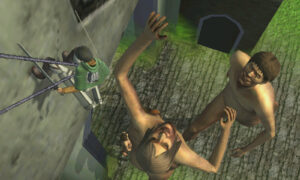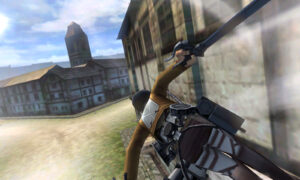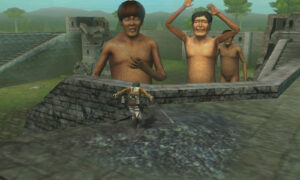Love it or hate it, chances are you’ve probably at least heard of Attack on Titan. It was easily one of the more popular anime series of yesteryear, with loads of merchandise even in American stores. Like any other anime that sells well, it was only a matter of time before a game was developed based around the show. Attack on Titan: Humanity in Chains is just that, depicting the events from the series almost verbatim, while allowing you to play them out for yourself.
For those who are unfamiliar with the plot, Attack on Titan is a dark, gory fantasy tale. Over a hundred years before the story began, giant creatures called Titans suddenly appeared and began terrorizing humanity, devouring anyone they could get their hands on. What is left of the humans now reside within three large sets of walls, which have done well to keep the Titans out until the outset of the anime’s plot, when a giant 200-feet-tall titan appears with a bolt of lightning and breaches the outer wall.
Lesser titans begin pouring in and devouring people, which is naturally quite bad for the populace as a whole. Cue the protagonist, Eren Yeager, his “sister” Mikasa, and best friend Armin. While attempting to escape their home to flee to the inner wall, Eren’s mother is captured by a Titan and eaten before his very eyes. While managing to escape himself, he vows revenge against the Titans as a whole, and he and his companions enlist in the military.
The Titans themselves are large, strange-looking humanoids, often with exaggerated proportions. Despite devouring humans, they have no need to eat, and will simply vomit up the humans they’ve consumed when their “stomach” becomes too full. They are hardy and have the ability to regenerate their wounds quite quickly, even if their limbs are entirely severed. The only weak point they seem to have is the nape of their neck, which is targeted by the human military’s swords—which seem to resemble oversized, common razor blades.
Another weapon in mankind’s arsenal is 3D Maneuver Gear, a gas-powered device that allows the user to speed along using grappling tethers. Within the walls of the city, this proves to be quite effective, allowing the military to rappel off buildings with ease, zeroing in on the Titan’s weak points. However, it loses its effectiveness tenfold when in an open area with no trees or buildings to grapple onto, rendering the device quite useless.
Since the game covers the anime’s story almost to the tee, that’s about all that needs to be said about it. If you haven’t watched the show, you’ll get roughly the same experience from the game, though to a lesser extent. If you’ve already seen the anime, you don’t need me explaining anything about it. The story in-game is told via animated scenes directly ripped from the show, in-game dialogue, and text. The animation looks quite good on the 3DS’ screen, luckily not compressed to the point of being choppy or blurry.
In fact, the game as a whole looks quite good, the graphics being somewhat impressive for the 3DS’ hardware. Some environments are reused, but the character models and Titans are well-rendered, and the game runs at a satisfying FPS. The animated cutscenes are of good quality, as well as the general UI of the game, which looks quite polished. Overall, there isn’t much to complain about in regards to visuals, though better hardware might allow the game to look even nicer.
Unfortunately, better hardware would also improve the gameplay. Most of Attack on Titan: Humanity in Chains is spent flying around on your 3D Maneuver Gear, slashing the weak points of Titans, with the occasional differing objective. On the 3DS’ single analog, the camera can get quite fiddly. You have to constantly reset the camera to be ahead of your player character, much like in Monster Hunter. What is different about this game is the sheer level of mobility, though. You’re often whipping about at high velocities, trying to systematically take down the baddies while avoiding their grabby hands. With bad camera control, this quickly becomes frustrating.
Another caveat about the gameplay is that it is fairly repetitive. After you’ve played the first ten or so levels, you’re going to have a general idea about how the rest of the game is going to play. Granted, they did try to add different objectives to spice things up, as well as a different mode of combat, (that gets slightly into spoiler territory!) but the game is based on an anime where there’s only really one type of combatant—Titans. It’s almost inherent that a game based on a show like that would be repetitive.
An additional complaint to level at the game is the music. While the opening cutscene of the game plays “Guren no Yumiyah” by Linked Horizon, which is an almost undeniably cool track, the rest of the game falls flat. In almost every battle I encountered, the same track was played, “D.O.A” from the anime’s OST. While not a terrible song in its own right, it gets quite annoying when you’ve heard it for the 15th level in a row. This just strikes me as being incredibly lazy.
In the end, it’s a bit difficult for me to recommend Attack on Titan: Humanity in Chains to anyone who’s not a die-hard fan of the series. If you are, there’s certainly much to be found here. It’s interesting to be able to play from the perspective of all the characters from the show, and the additional AoT content might be enough to hold you over until the anime’s second season in 2016. However, if you’re not interested in the show, or just straight-up didn’t enjoy it, I’m fairly certain you already know that this title isn’t for you.
Attack on Titan: Humanity in Chains was reviewed on 3DS using a review code provided by ATLUS. You can find additional information about Niche Gamer’s review/ethics policy here.
The Verdict: 6
The Good:
- Animated cutscenes look great.
- A nice story companion to the show.
- Well-done graphics and UI.
The Bad:
- Repetitive gameplay.
- Wonky camera controls.
- Gross repetition of the same music track in almost every level.






